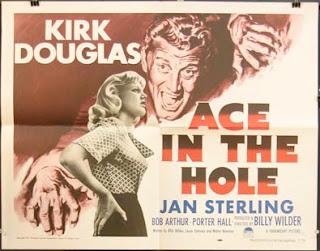
Edward R. Murrow, American journalist extraordinaire, once said “To be persuasive, we must be believable. To be believable, we must be credible. To be credible, we must be truthful”. But as movies have shown us over the years (Picture Snatcher, Network, Absence of Malice), members of the press can be just as ambitious as the politicians and businessmen they’re paid to keep tabs on, and won’t let anything – not even the facts – stand in the way of a good story.
Yet in the long history of Hollywood, there hasn’t been a reporter quite as merciless or corrupt as the lead character in Billy Wilder’s 1951 masterpiece, Ace in the Hole.
Having been fired from all the big city newspapers, Chuck Tatum (Kirk Douglas) is forced to take a job with the Albuquerque Sun-Bulletin, where he hopes to eventually land a story so big it will put him back on top. His break comes when he and his young photographer Herbie (Robert Arthur), en-route to cover a rattlesnake hunt, stop at a small desert gas station and discover that a man has just been trapped in a nearby cave-in.
It turns out the owner of the station, Leo Minosa (Richard Benedict), was gathering ancient Native American pottery in an old cliff dwelling when the ceiling collapsed on top of him. His leg pinned under a rock, Leo can’t get out, and with the rest of the cave looking like it might give way at any minute, rescuing Leo isn’t going to be easy.
Convinced he can turn Leo’s plight into a nationwide headline, Tatum- with the help of both Leo’s unhappy wife Lorraine (Jan Sterling) and Sheriff Kratzer (Ray Teal) - manages to slow down the rescue operation, just long enough to draw the attention of every newspaper in the country.
As word gets out, people flock to this tiny town to root Leo on, and, sure enough, Tatum’s bylines make him a celebrity. But will poor Leo survive long enough to give Tatum the happy ending his story needs?
Kirk Douglas is at his slimy best as Chuck Tatum, a guy who has been fired from more newspapers than he can count, and for a variety of reasons (from drunkenness to having an affair with the editor’s wife). Yet his past failings have done nothing to bruise his ego; on the contrary, Chuck Tatum is as arrogant as ever, promising his co-workers that it won’t be long before New York comes calling again. When the Leo Minosa story lands in his lap, it’s like a dream come true, and Tatum quickly gets down to business, bribing officials (to get exclusive rights to the story) and stalling the rescue workers (to ensure he has enough time to turn Leo’s plight into a sensation). Douglas, who also played an anti-hero in 1949’s Champion, is so convincingly ruthless throughout Ace in the Hole that, as much as you hate him, you can’t wait to see what he does next.
Tatum isn’t the only shady character to be found in Ace in the Hole; Jan Sterling’s Lorraine, Leo’s disgruntled wife, had packed her bags, ready to leave the trapped Leo before Tatum convinced her there’s money to be made if she sticks around (later on, she even flirts with Tatum). Then there’s Ray Teal’s sheriff, who - urged on by Tatum - uses his influence to keep Leo trapped until his newfound popularity wins him re-election.
On the flip-side is the victim, Leo, a simple-minded guy who actually believes Chuck Tatum is his friend, and doing everything in his power to save him. Whereas Tatum and company will have you seeing red, the scenes featuring Benedict’s Leo are bound to bring a tear to your eye.
This superb cast, coupled with Wilder’s sharp direction and even sharper script, helped make Ace in the Hole one of cinema’s bleakest condemnations of the Fourth Estate, and one of the darkest - yet at the same time most engaging - of all the film noirs.
Rating: 10 out of 10
